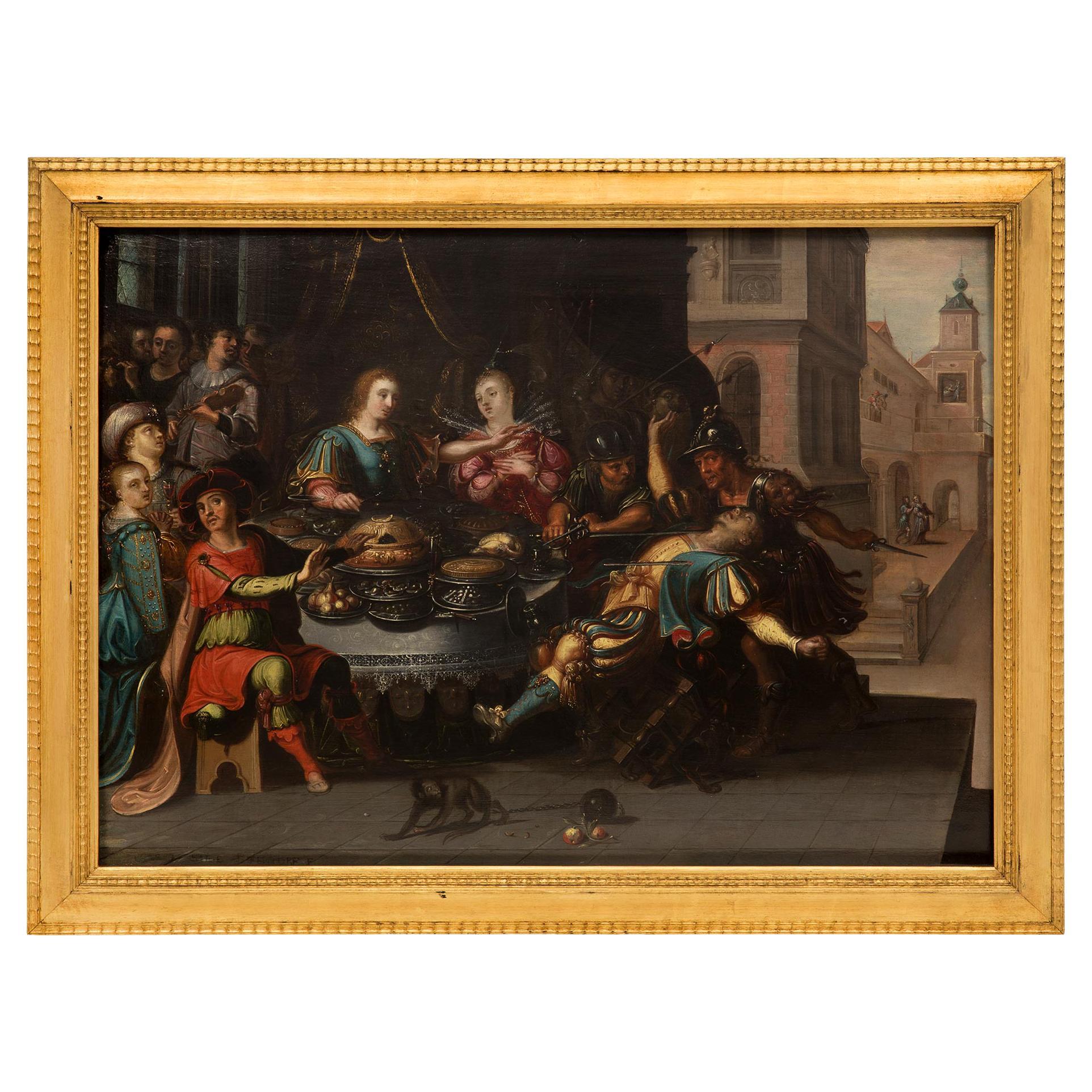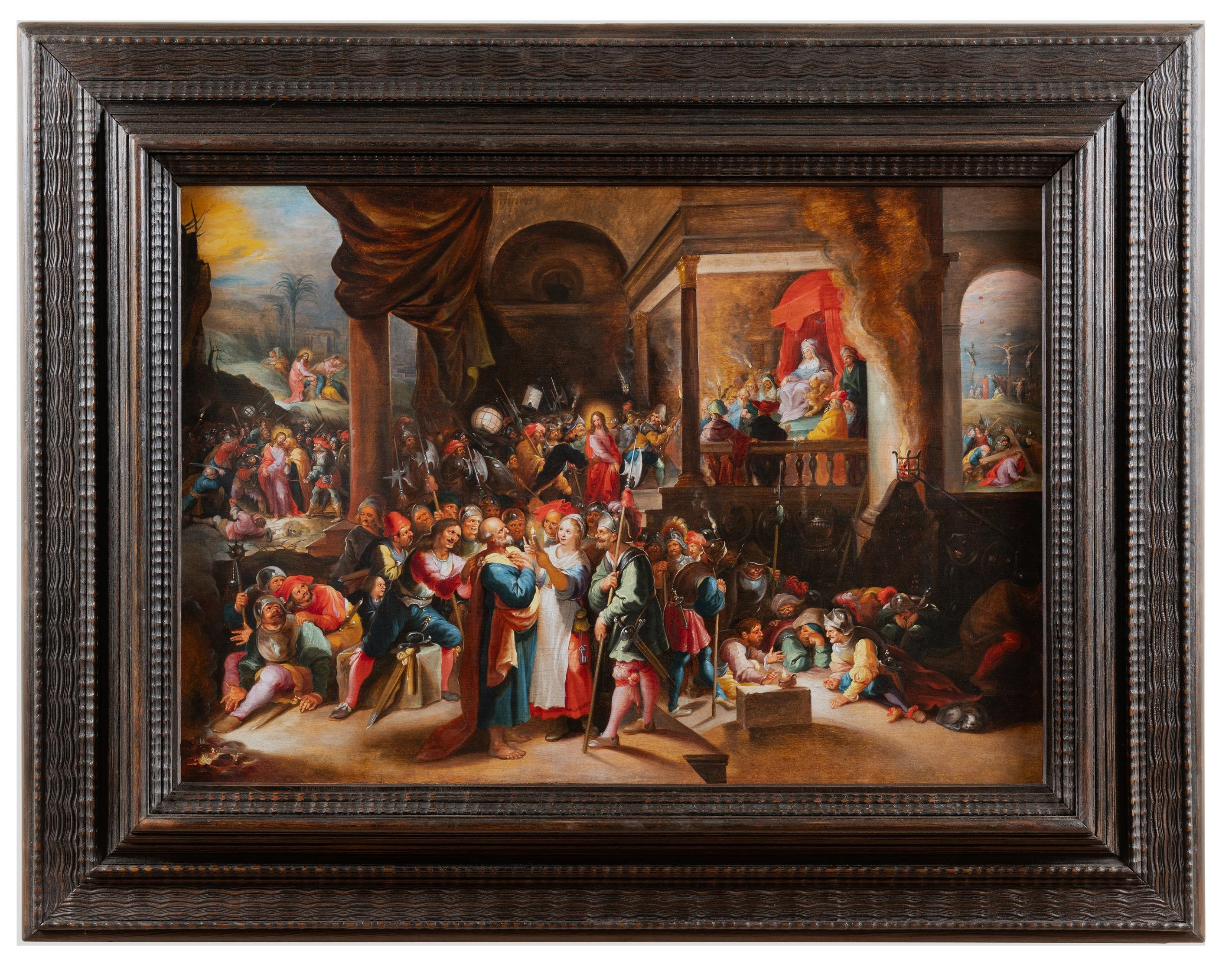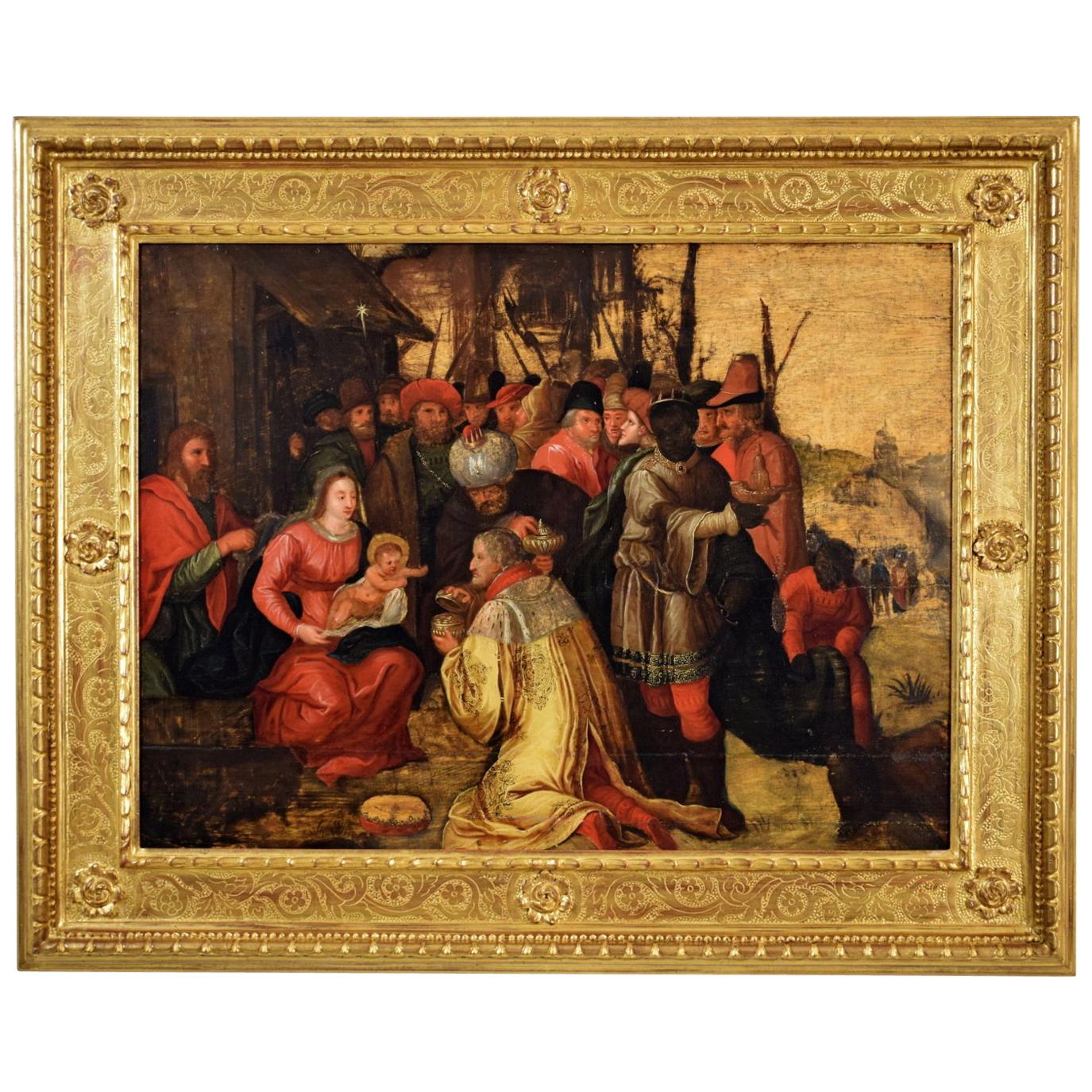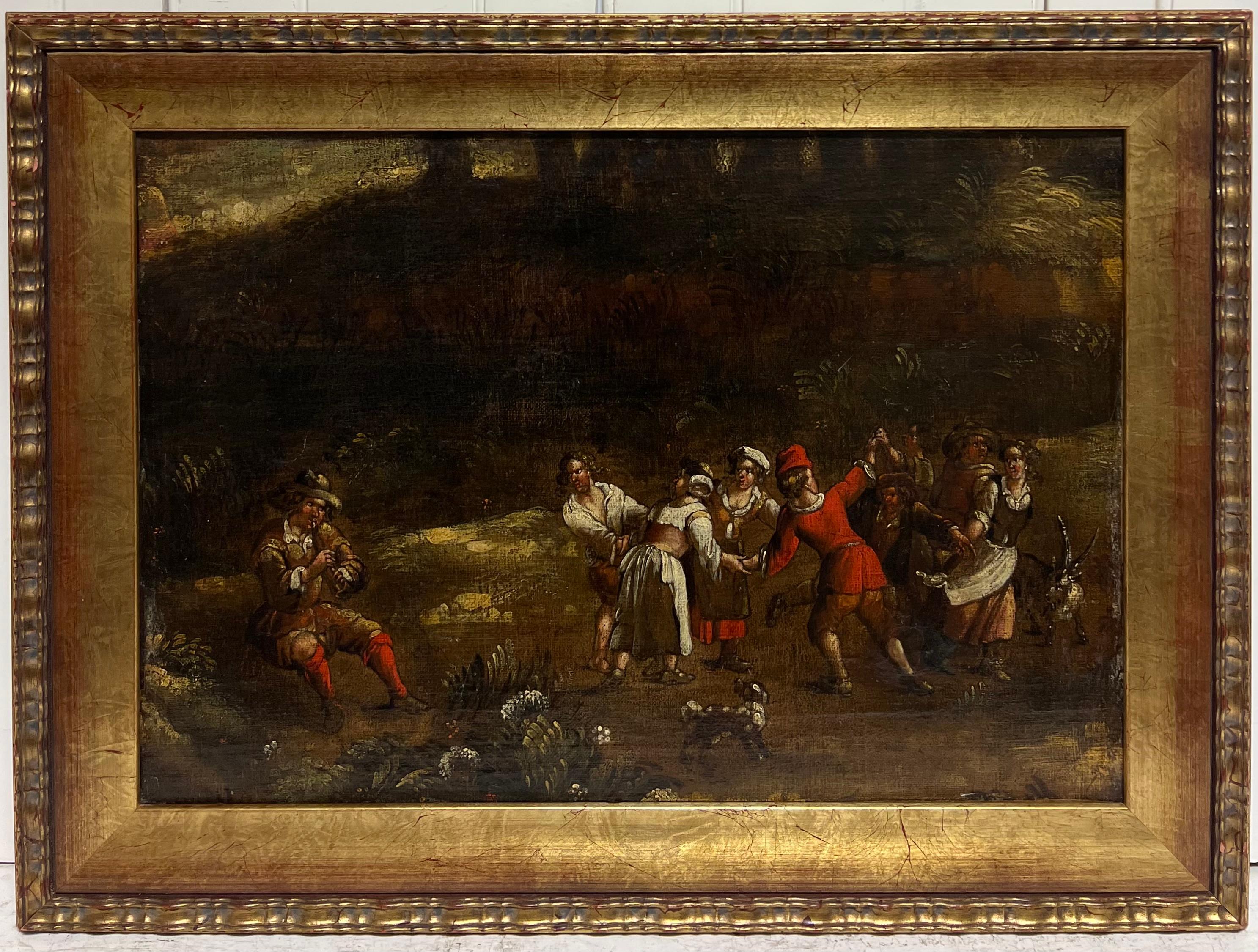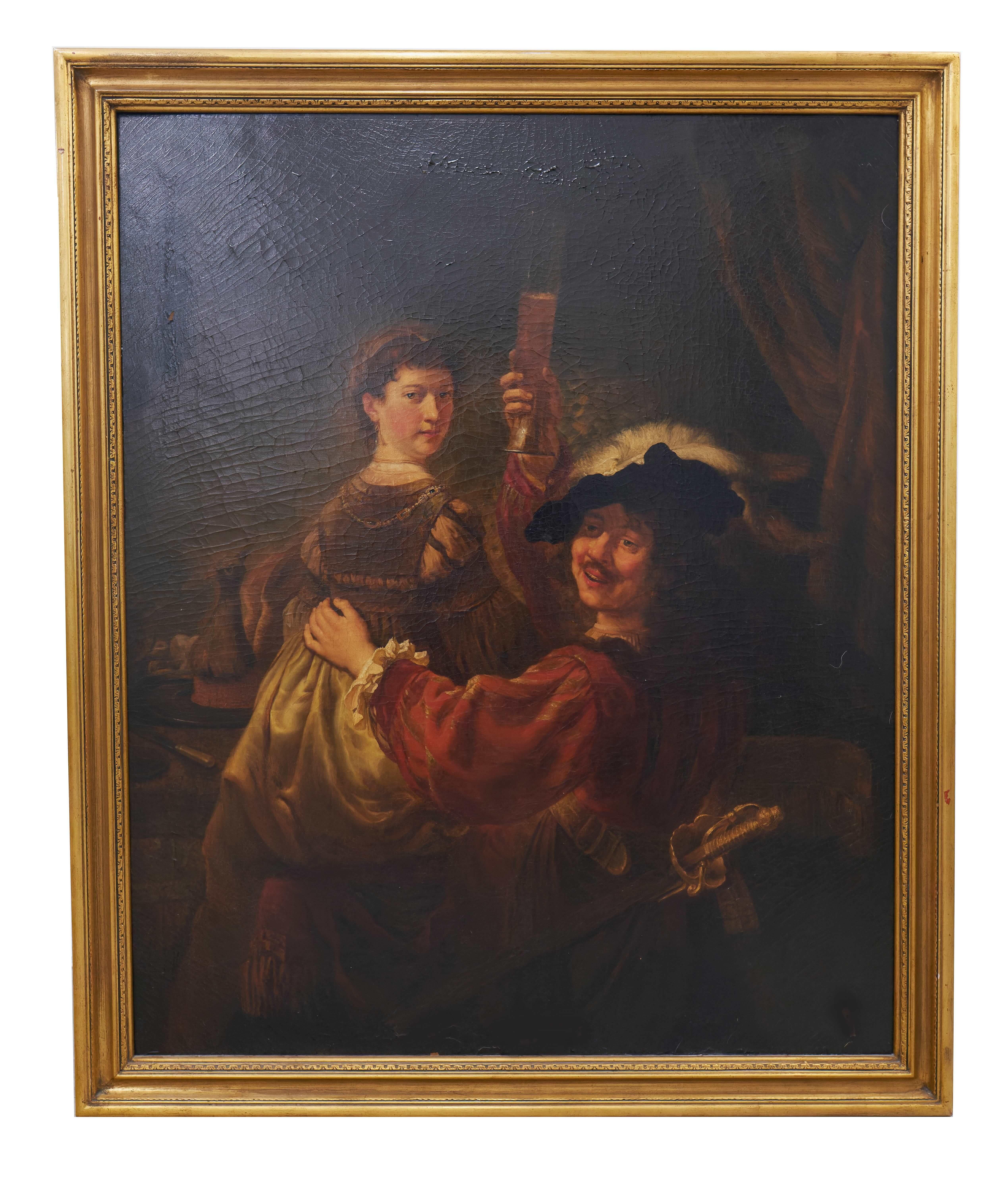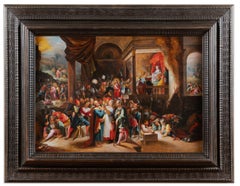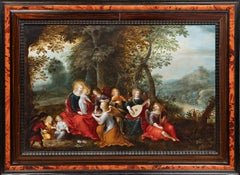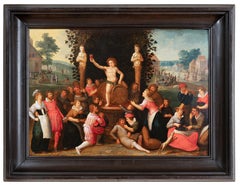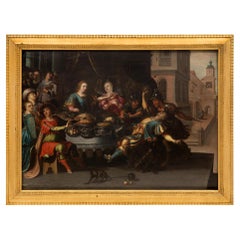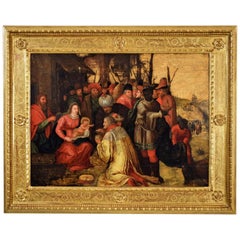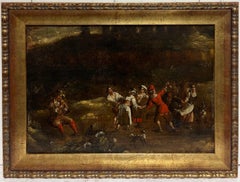Items Similar to Attributed à H. Francken II, 17th c. Anwerp - The prodigal son among courtesans
Want more images or videos?
Request additional images or videos from the seller
1 of 16
Attributed à H. Francken II, 17th c. Anwerp - The prodigal son among courtesans
$27,212.72
£20,573.52
€23,000
CA$38,049.99
A$41,584.21
CHF 21,882.94
MX$498,075.71
NOK 275,418.72
SEK 257,230.37
DKK 175,224.77
About the Item
The Prodigal Son Among Courtesans
Attributed to Hieronymus Francken II (Antwerp 1578-1623)
Early 17th century Antwerp school
Oil on oak panel,
Dimensions: H. 52.5 cm (20.67 in), W. 74 cm (29.14 in)
Flemish-style moulded wood frame
Frame: h. 78 cm (h. 30.70 in.), w. 100 cm (39.37 in.)
At first glance, this festive and joyful painting depicts a group of elegantly dressed people dancing to the sound of an orchestra in a richly decorated interior with a wide opening onto a rural exterior. However, the real theme is cleverly concealed by the painter and is only discernible through the artifice of a small scene in the background where we see a half-naked man, in the company of the pigs next to a makeshift shelter.
In fact, beyond the pleasant and apparently superficial character of the painting, it is a subject taken from the parable of the prodigal son in the Gospel. The illustrated episode is the prodigal son among courtesans.
Even if the viewer's attention is drawn to the central couple (prodigal son embracing a pretty courtesan) doing the dance steps, the artist takes care in a narrative approach of all the groups and ancillary scenes in order to create a rich and varied composition. Thus the musicians seated on a raised platform are depicted with great skill, their faces animated, their clothes abundantly varied.
The theme of music, which has always been associated with that of sensuality and physical love, helps to exacerbate licentious pleasures.
The merry company dances "Spanish pavane", a slow court dance from the sixteenth century, danced close to the ground by couples arranged in a procession, which was probably introduced to the south of the Netherlands around 1600 during the governance of Albrecht VII and the daughter of the King of Spain Isabella Clara Eugenia in Brussels.
The interior of the house is also carefully elaborated, the embossed leather dyes on the walls, the middle sideboard (typical in Francken interiors), where the rich gold and silver crockery is placed in front of the painting "Andromeda chained to the rock and Perseus arriving to rescue her". The inclusion of a contemporary and probably extant pictorial work is also one of the characteristics of the Francken family, among them Frans Francken the Younger is particularly known for his numerous interiors of amateur cabinets.
In the foreground, on the left, a table laden with fine food and precious crockery indicates the banquet that took place before the dance. The painter places several objects whose symbolism serves to reinforce decay and abuse: glasses filled with wine (drunkenness), a knife whose handle leans unbalanced at the edge of the table (instability), open oysters (the image of carnal pleasure), a broken lemon (a life started: symbol of the bitterness of the passing of time).
Finally, in the third left ground, two men standing, wrapped in cloaks, look at the whole scene, one can easily imagine two bandits who have arrived to steal the prodigal son's money, their weapons hidden under their coats. No matter how it happens again, the prodigal son will end up ruined, even leaving his shirt there, and this is how the painter depicts him in the background: kneeling among the pigs, he seems to reflect on his downfall and decides to return to his father. In reality, the Gospels remain very discreet about the details of the debauchery life of the young man who went to squander his inheritance, yet there is a whole tradition in Antwerp painting from the sixteenth century onwards to complacently depict the debauchery of the prodigal son: meal, drink, gambling, courtesans. This technique makes it possible to divert a religious subject into a secular one.
The story of the Prodigal Son, which is constantly in the moralizing spirit, also serves as a pretext to point out licentious and amoral behavior. The decay embodied by the eviction from the brothel and life among the pigs are always relegated to the background. The proscenium, on the other hand, emphasizes the pleasures of music, dance and the flesh. Sin is absolute! This way of representing ball scenes in an interior at the Francken house would come from Hieronymus I Francken (around 1540-1610), who worked at the court of France at the end of the sixteenth century and was inspired by the many balls that took place there. His nephews, Frans Francken II and Hieronymus Francken II, were inspired by their uncle's compositions while adapting the ballroom scenes to their Flemish clientele, incorporating biblical morality against excesses into their works.
Related works:
Some works are very close to our painting with some minute variations in the setting or the characters' clothes.
• Koller auction, Zurich, 22/03/2013, oil on copper, by Hieronymus Francken II, signed DEN ION franck f (h. 44,5 cm, w. 65,5 cm)
• Christie’s New York 31/01/2013, oil on panel, h. 61 cm, w. 85 cm, by Hieronymus Francken II
• Musée de Tessé, Le Mans, After Hieronymus I Francken (Herenthals c. 1540 - Paris 1610) Ball during the reign of Henri III, oil on panel
• Private collection, illustrated in Ursula Harting, dated 1607, by Hieronymus Francken II, p.178 n. 150 (Frans Francken Der Jüngere (1581-1642). Die Gemalde mit kritischem oeuvrekatalog, 01/01/1989 Edition : Luca Verlag, monography on Frans Francken the Younger as well as his family)
Other compositions differ from ours, but have many similarities:
• The Prodigal Son Among Courtesans, Musée des Beaux Arts de Nimes, by Hieronymus I Francken, oil on panel
• Dance lesson, Musée des Beaux-Arts de Cambrai, by Hieronymus Francken II, oil on panel, h. 54 cm, w. 80 cm,
• The Prodigal Son Among Courtesans, Musée de Brou, Bourg-en-Bresse, by Frans Francken II, oil on copper, h. 40 cm, w. 52 cm, , signed Do. Franck
• Dancing company, Lempertz Auction, Köln, 14 May 2011, by Hieronymus Francken II, oil on panel, h. 49,5 cm, w. 71 cm
Hieronymus Francken II (Antwerp 1578-1623)
Hieronymus Francken II was the son of Frans Francken the Elder. His father was a painter born in Herentals who had moved with his painter father to Antwerp. There he had become one of the leading painters of the Counter-Reformation. Hieronymus had three painter brothers: Thomas, Frans II, and Ambrosius II. Hieronymus received his first training from his father. He was entered in the books of the Antwerp Guild of St. Luke in 1605 as a pupil of his uncle Ambrosius. In 1607, Hieronymus Francken II was officially admitted as Master of the Antwerp Guild. In 1609 he probably spent time in Paris, where, like his brother Frans II, he is said to have studied under his uncle Hieronymus Francken I. Hieronymus Francken I worked most of his life in Paris and Fontainebleau and was court painter to France from 1594. Hieronymus Francken II returned to Antwerp where he spent the rest of his life.
Hieronymus Francken the Younger was a versatile artist who practiced many genres. Hieronymus painted art galleries and cabinets of curiosities, genre scenes of balls and gallant dances, history paintings, antics, allegorical paintings, and still lifes. He also copied some witchcraft scenes, invented by his brother Frans II.
- Attributed to:HIERONYMUS FRANCKEN II (1578 - 1623, Flemish)
- Dimensions:Height: 30.7 in (77.98 cm)Width: 39.37 in (100 cm)
- Medium:
- Movement & Style:
- Period:Early 17th Century
- Condition:Professionnally restored, ready to be hanged and enjoyed.
- Gallery Location:PARIS, FR
- Reference Number:1stDibs: LU2433213372612
About the Seller
No Reviews Yet
Vetted Professional Seller
Every seller passes strict standards for authenticity and reliability
1stDibs seller since 2023
17 sales on 1stDibs
- ShippingRetrieving quote...Shipping from: PARIS, France
- Return Policy
More From This Seller
View AllHieronymus FRANCKEN III - The Denial of Saint Peter, 17th c. Antwerp school
Located in PARIS, FR
Hieronymus FRANCKEN III (Antwerp 1611 - 1671)
17th century Antwerp School
The Denial of Saint Peter
Oil on panel, dim. h. 53 cm, l. 76 cm
Framed, h. 82 cm, l. 106 cm
Sold with the ...
Category
Mid-17th Century Old Masters Figurative Paintings
Materials
Oil, Wood Panel
Madonna and Child with Angels, attributed to Louis de Caullery, Flemish, 17th c.
Located in PARIS, FR
Madonna and Child with Angels
Attributed to Louis de Caullery (1565 -1622) for figures & Abraham Govaerts (1589 - 1626) for landscape
Not signed
17th century Antwerp school, circa 16...
Category
Early 17th Century Old Masters Figurative Paintings
Materials
Copper
Allegory of Autumn with Bacchus, studio of Louis de Caullery, 17th c. Antwerp
Located in PARIS, FR
Allegory of Autumn with worship of Bacchus
Studio of Louis de Caullery (Caullery, vers 1580 - Anvers, 1621/22)
17th century Antwerp school
Not signed
Oil on oak panel
Dimensions : p...
Category
Early 17th Century Old Masters Figurative Paintings
Materials
Oil, Wood Panel
Flemish 17th c., Allegory of war and peace, circa 1630, by Adriaen van Stalbemt
Located in PARIS, FR
Adriaen van Stalbemt (Antwerp, 1580-1662)
Allegory of Peace and War, circa 1620-1630
Oil on oak panel: h. 49.5 cm, l. 73.2cm (19.29 x 28.74 in)
Giltwood ...
Category
Early 17th Century Old Masters Figurative Paintings
Materials
Oil, Panel
The Rape of Europa, signed Peter Sion (1624-1695), Antwerp, 17th century
Located in PARIS, FR
The Rape of Europa
By Peter Sion (Antwerp, 1624-1695)
Signed in the lower right corner P. Sion
17th century Antwerp School
Oil on copper, dim. h. 53 cm, w. 45 cm
Moulded and ebonized...
Category
17th Century Old Masters Figurative Paintings
Materials
Oak, Oil, Wood Panel
17th c. Antwerp studio of J. Brueghel & H. van Balen - The Virgin with Child
Located in PARIS, FR
Workshop of Jan Brueghel the Younger (1601-1678) & Hendrick van Balen (Antwerp, 1575 – 1632)
17th century Antwerp School
The Virgin and Child ...
Category
1630s Old Masters Figurative Paintings
Materials
Oil
You May Also Like
Dutch 17th Century Oil on Wood Painting in the Manner of Frans Francken
Located in West Palm Beach, FL
A sensational Dutch 17th century Oil on Wood painting in the manner of Frans Francken. The painting depicts the scene of a feast with a young male and female enjoying a feast while musicians are playing music in the background. To the left of the table that are spectators who are turning their heads away from two guards killing a traitor seated at the table. In the background you have architectural buildings and additional figures. At the bottom center is a pet monkey...
Category
Antique 17th Century Dutch Paintings
Materials
Canvas, Giltwood
Banquet Attrib to Van Den Hoecke Religious Oil on Table Old Master 17th Century
By Gaspar van den Hoecke (Antwerp, 1585 - 1648)
Located in Riva del Garda, IT
Gaspar van den Hoecke (Antwerp, 1585 - 1648)
Herod's banquet
Early 17th century
oil on panel, with gold highlights (in the guise of Salome and in the curtains of the building in the background)
56 x 80 cm.
framed 72 x 90 cm.
Note: The painting probably dates from an original by Frans II Francken (1581 - 1642), which is shown under the number 0000344789 in the RKD.
Valuable oil painting on panel depicting King Herod and the beautiful Jewish princess Salome according to the episode taken from the Gospel of Matthew (14.3-11), which sees her as the protagonist in the story of the martyrdom of John the Baptist. The event shown is a cross between history and legend, a myth faced for centuries by artists in every field: Caravaggio in painting, Oscar Wilde in theater, Richard Strauss...
Category
17th Century Old Masters Paintings
Materials
Oil
$15,381 Sale Price
20% Off
Frans Franken III 16th Century Oil on Wood, Adoration of the Magi, Painting
By Frans Franken the Younger
Located in IT
Frans Franken III and aid, Adoration of the Magi
Good condition
The oil painting on wood, with a gold background, depicts an Adoration of the Magi. The Magi are dressed in sumptuous silk and brocade dresses; they wear precious hats and jewelery. The richness of their garments is in contrast with the humility of the Holy Family and of the other characters who, around curious, observe the scene. The hut is simple, made of wood and straw: above it shines the Comet, symbol of the divine event. In the distance, a group of wayfarers walk along a path that is lost on the horizon, blending into the gold of the bottom.
The representation proposes a traditional iconography, in which the painter inserts some details that he lends himself to symbolic interpretations. Among these is the appearance of the Magi, who from the XIVth century differs iconographically: the wise astronomers represent the homage to Jesus of the then known parts of the world, namely Africa, Asia and Europe. To the right of the Magi, in the foreground, sits a monkey, considered a demonic creature and a symbol of lies and sin. It is depicted on the sidelines, as a defeat, next to a fragment of a classical column: ruin alludes to the end of paganism, of the old world that collapses with the advent of the new one, marked by the birth of Christ and liberation from the Original Sin. On the ruins he climbs the ivy, symbol of the immortality of the soul. The work is attributable to the workshop of the Flemish painter Frans Francken III...
Category
Antique 16th Century Belgian Renaissance Paintings
Materials
Paint
17th Century Flemish Old Master Dancing Figures Musicians Antique Oil Painting
Located in Cirencester, Gloucestershire
Dancing Figures
Flemish School, 17th century
oil on on canvas, framed
framed: 21.5 x 28.5 inches
canvas : 16.5 x 24 inches
Provenance: private collection, France
Condition: very good...
Category
17th Century Baroque Figurative Paintings
Materials
Oil
$2,458 Sale Price
30% Off
After Rembrandt "The Prodigal Son in the Tavern" Old Master Style Painting
Located in San Francisco, CA
After Rembrandt
"The Prodigal Son in the Tavern"
Old Master Style Painting
Late 19th century - Early 20th century
Oil on Canvas
36.75 x 44.5 unframed
40.5" x 48.5" framed
Category
Late 19th Century Dutch School Portrait Paintings
Materials
Canvas, Oil
Huge 1700's Dutch Old Master Oil Painting Elegant Court Figures Musical Soiree
Located in Cirencester, Gloucestershire
Artist/ School: Dutch School, early 1700's.
Title: Elegant Court Figures at a Musical Soiree.
Medium: oil painting on canvas, unframed.
Size: painting: 40 x 49.5 inches
Provenanc...
Category
Early 18th Century Figurative Paintings
Materials
Canvas, Oil
$8,027 Sale Price
30% Off
